Our Comprehensive Guide to Referral Marketing
“Referral marketing is the science of converting customer’s social capital into brand’s economic capital. “ [Harvard Business Review]
Referral marketing is the only marketing channel that helps you capitalize on word-of-mouth advocacy and grow organically. Unlike paid-advertising that brings you random visitors, referral marketing is a much more optimized marketing strategy that enables people who love your product to bring in people who would love your product, too.
It not only improves the quantitative metrics, but also the qualitative metrics. It connects you with the right set of audience, thereby improving conversions and driving revenue. Dropbox, Airbnb and Uber are some of the stronger examples of billion-dollar companies that have taken advantage of the potential of referral marketing.
Many marketers make the mistake of taking referral marketing as a simple one-step transaction between the referrer and the referred user with a dangling reward. Many feel that there are one-in-a-million chances that referral marketing would help them go viral.
However, the truth is that referral marketing is not just a theory, but an exact science of turning your customer’s social capital into your business’ economic capital. As per a Nielsen survey, referral marketing is still the most trusted form of advertising, and also the most profitable one
The best part is that referral isn’t super complex. In fact, once you get the basics right, it’s the easiest thing to do. In this guide, I’ll walk you through some of the most basic rules of referral marketing, so that you can lay the groundwork and kickoff on the right note.
Make Your CTA Easy to Discover.
“Advocacy can propel a brand unlike any other paid or unpaid media because it unlocks the networking power of one-to-one relationships with a key of trust.” – Rick Wion.
Referral marketing starts with creating awareness.
You might have the best product or the most rewarding referral program in the world, but if you don’t make your users aware about the opportunity, you’re not fully utilizing the potential of referrals.
As per a Zendesk report, 87% users are more likely to share a product/service, after they have had a good experience. However, the study found that only 33% users shared their positive experience with 5+ people, while only 23% users shared it with 10+ people.
That means, on an average, brands lose 50% of their advocates, despite delivering a positive experience. If you ask me, that’s just missed opportunity.
Imagine your growth graph, if every newly acquired user, whom you made happy, brought 5-10 more users. That would be organic growth at its best, and that, too, at reduced CAC and almost zero spend on advertising.
Many startups succeed in creating a great product experience and even have a decent NPS (net promoter score), but not all of them capitalize on the visitor’s delight and convert those into referrals. That’s because their referral links are hidden one or two layers beneath the menu, and users have a hard time finding it.
That’s #1 tip for brands approaching referral marketing– put your referral link where your advocates can see them.
Don’t put it on your landing page. Don’t put it on your “About Us” page. Don’t bury it two layers inside your app settings. Instead, put them in user’s main menu screen, so that it’s visible to them, everytime they use your product.
For instance, look how TabTor places its “Refer a Friend” Link on top of the user menu, so that it’s easily accessible. The placement is crucial, because it’s extremely accessible and reminds the user every time they interact with the app that they can refer their friends.
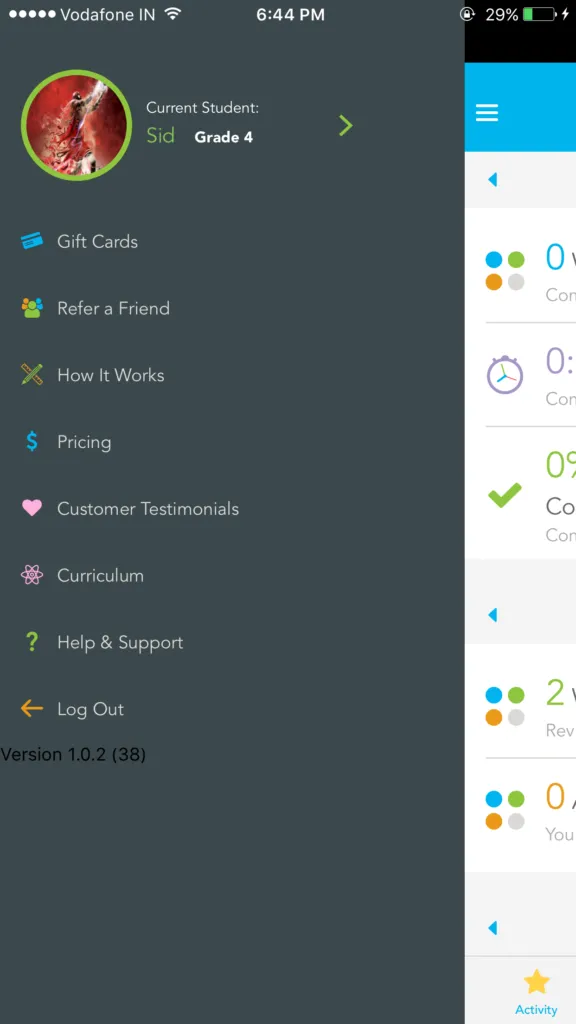
And it’s not just Tabtor that does it. Look how Uber puts its “Free Rides” link on the main user menu to maximize conversions:
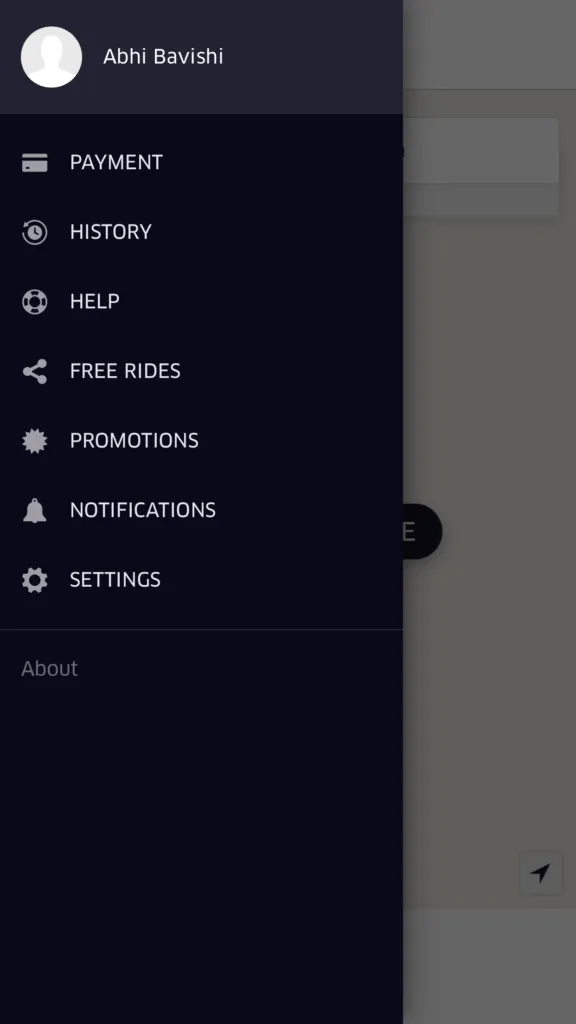
The CTA placement is perfect, because:
- It’s almost impossible to miss: Isn’t every user going to tap on the menu, at least once?
- It’s easily accessible during the entire customer lifecycle: Users can access the referral link when they’re riding a Uber, checking out the availability or when they have successfully completed a ride.
- It encourages users to take action: The usage of words, like, “Earn” and “Free” makes the CTA tempting for users to checkout.
By getting the CTA placement right, Uber increases the visibility and accessibility of its referral marketing campaign, which is crucial to maximizing the overall referral percentage.
Spread the Love.
“It is wise to persuade people to do things and make them think it was their own idea.” – Nelson Mandela
Once you have put the word out, the next step is to get users to act.
Now, the most straight-forward way to get users to act is to offer them a reward. For instance, how Uber offers free rides or how BusBud offers free travel money for every successful referral.
While the strategy is highly effective, it’s important to wrap the reward in an emotional package and offer it to customers, so that users feel comfortable sharing it.
As per Ernest Ditcher, who published an article on Harvard Business Review on what motivates a person to talk about brands, there are the four primary factors that contribute towards brand advocacy:
- Product involvement (33%): The end-user’s experience is so delightful that he/she can’t resist sharing it.
- Self-Involvement (24%): The user is the first one to try the product in his/her close circle or has exclusive information about the product.
- Other Involvement (20%): The user wants to help others, especially the ones he/she deeply cares about.
- Message Involvement (20%): The message that the brand delivers is so valuable that the user attaches his/her identity to it, and feels that it needs to be shared.
It’s important to note that 0% users were motivated to share a product, because it offered them any monetary benefits. Rather, the primary motivation for referring a product was to share a delightful experience with their loved ones.
That’s tip #2 for brands– make referrals about sharing, not earning.
Motivate users with rewards, but don’t miss out on the emotional connection. Use positive images and quotes to encourage referrals. Offer dual-sided rewards, so that users don’t feel bad or selfish, when they make a referral.
For instance, notice how BusBud offers $5 to the referrer as well as their friend(s), when they travel.
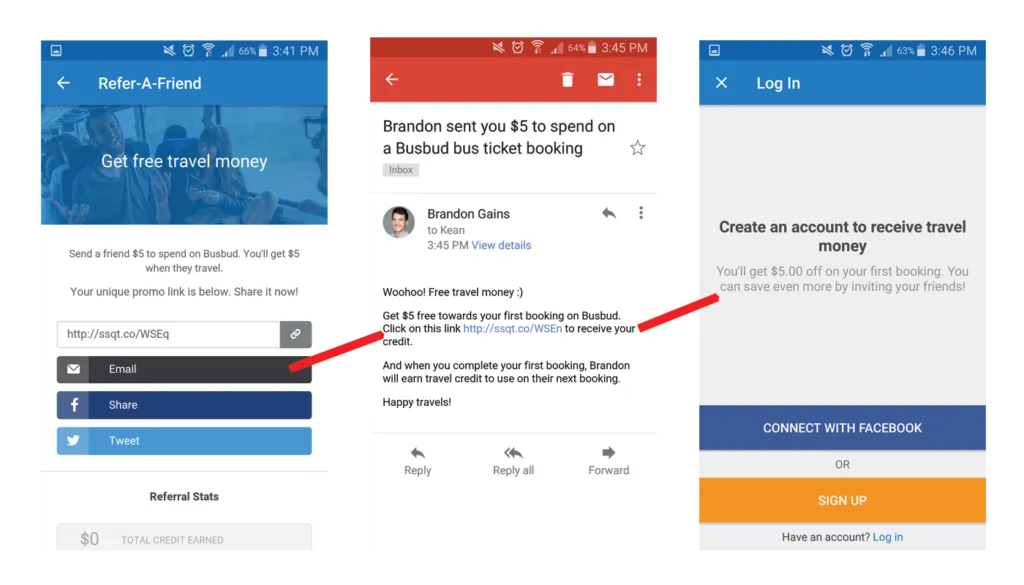
It just triggers the right kind of emotions in the user, and makes them feel good about putting a referral.
Had BusBud offered $10 the referrer and no reward for their friends, you might have felt a bit hesitant about sharing the request to a lot of friends. It’s also less likely that anyone would have joined, as the referral would seem outright selfish, with no reward being offered for onboarding.
Therefore, when you design your referral marketing campaign, make sure that you motivate users to share experiences, and offer equitable rewards to advocates as well as referred users.
That way, you will reduce the inherent social barrier, and make users feel good about sharing experiences and talking about your brand.
People love FREE stuff.
As per psychologist Dan Ariely, who studied the zero-price effect, the value of the service being offered increases immensely when it’s being offered for FREE.
For instance, there was no huge mass appeal for taxi aggregators, until Uber started offering free car rides to its users. Uber’s referral marketing scheme of offering FREE rides to new users was sheer marketing genius, because:
- It provided risk-free trial to new customers.
- It helped built up a strong referral network, thereby building brand loyalty.
- It guilt-tripped users into using the service.
As per Zero-price effect, when a product/service is being offered for free, we immediately jump onto it, because we perceive no apparent downside to the “free” option.
For instance, notice how Chipolo amplifies the desire to join the referral program by offering a Free Chipolo to every user that successfully makes a referral to their loved ones.
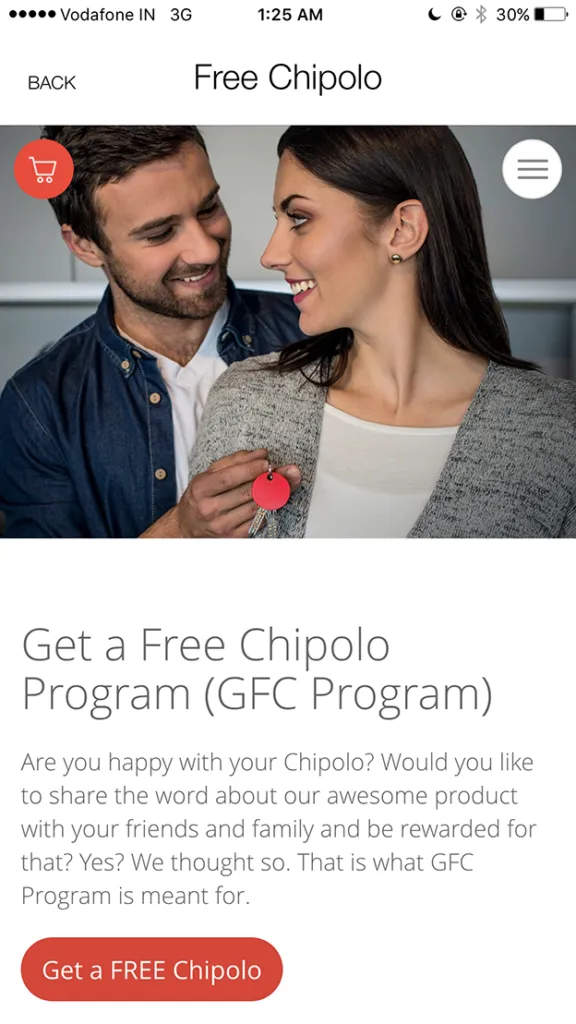
Through its GFC program, Chipolo reduces the activation gap, builds up brand loyalty and encourages power-users to keep referring. Since there’s no downside to signing up for a referral program and sending invites, the conversion rate for GFC is incredibly high.
And that’s not it.
According to rule of reciprocity, which is a widely accepted theory in social psychology, humans are wired towards paying back what they received from others. So, for instance, if you’re offered a FREE Chipolo, you’re either going to buy more (to return the favor), or you’re going to continue spreading the good word about the product.
The beauty of this marketing strategy is that no matter which option you choose, you’re either going to increase your LTV or decrease your CAC. It’s an absolute win-win for your brand.
That’s #3 tip for brands– take the freeway to referral marketing.
Personalize Referrals.
“People buy from people they know, like or trust.”- Joel Comm
It’s a well-established consumer psychology– people buy from people they trust. And that’s because it reduces the risk of making a wrong purchase, simplifies decision making and reduces the active involvement of the consumer in the product.
For instance, if a friend refers you to Uber, you’re going to pay attention to the referral and give it a try. But, if Uber had tried sending you an invite directly, with a much higher reward, there are chances that you wouldn’t have taken that sweet-deal.
Why? Because, you don’t know Uber, yet.
That’s the reason these brands don’t use professional email marketing or cloud based services to send referrals. Instead, they encourage users to share the referrals through their own personal communication channels, like Gmail, WhatsApp, Facebook or Twitter.
For instance, when you click on the “Free Rides” CTA in Uber, you get the following screen:
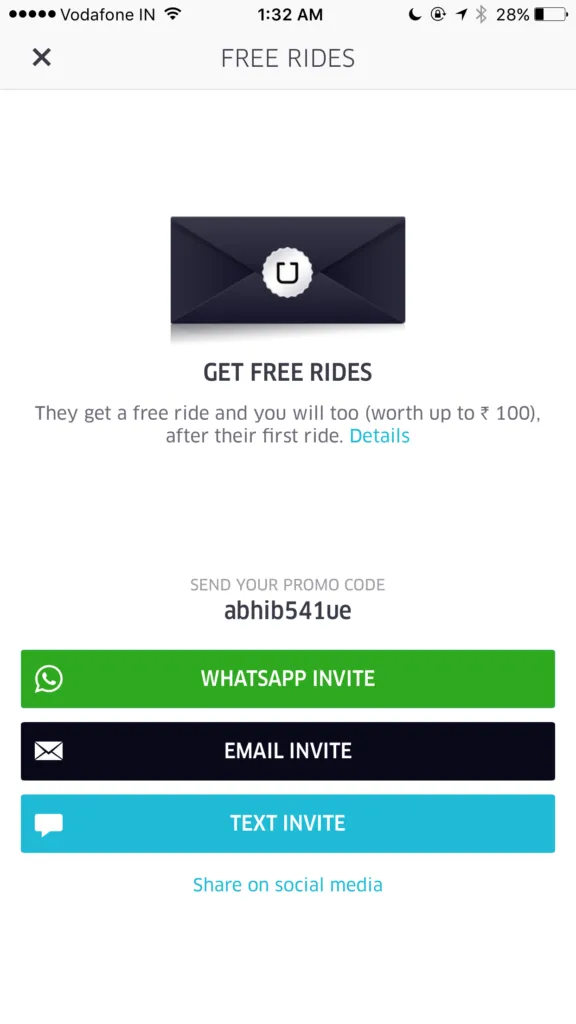
Notice how Uber encourages you to share the referral link through your own personal communication channels i.e WhatsApp, Email, Text or social media. When you click on any of the send invite buttons, you get a personalized message with the referral code inside.
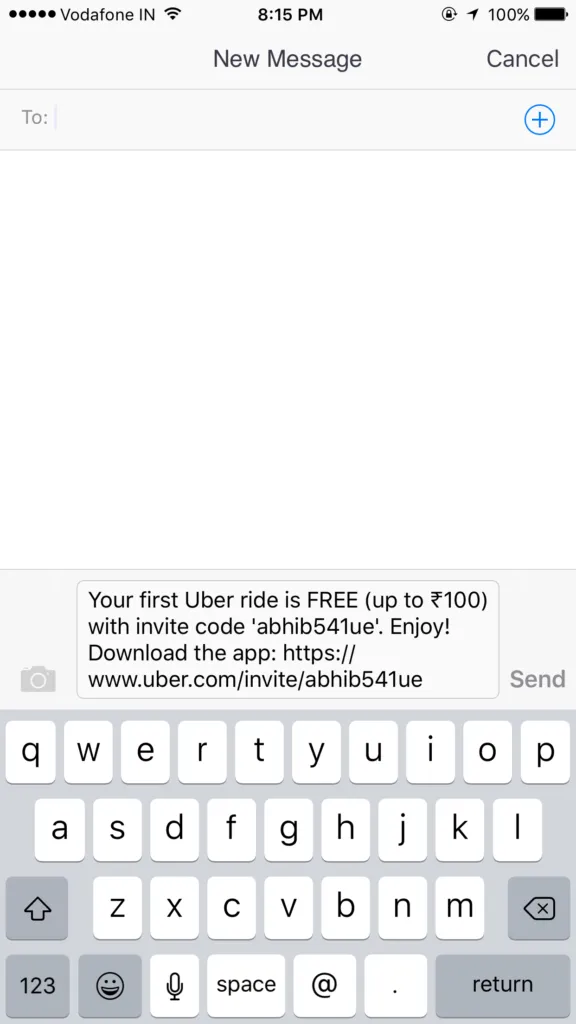
What do brands achieve by personalizing messages? Well, an awful lot. Here’s what happens when you personalize referrals:
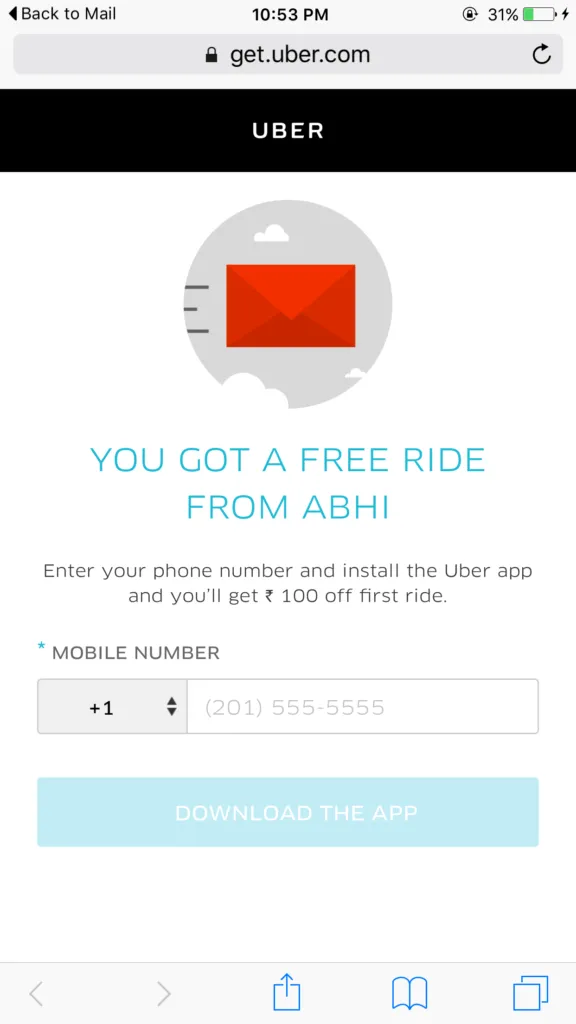
-
- Higher Conversions: Since the referral is being sent through the referrer’s personal communication channels, it does not come as a “click-bait” tactic. Referred users are more likely to open a link from their personal contact than read an email from a relatively unknown brand. For instance, look how Uber personalizes the referral email by including the name of the referrer. Despite being a minor hack, the feature goes a long way in driving conversions.
- Brand Loyalty: According to behavioral psychology, it’s hard for a person to have an inconsistent set of beliefs. For instance, if someone refers you to try an app, it’s hard for him to go against it, as every individual seeks consistency among their cognitions. Therefore, personalizing referrals massively improves brand loyalty, as referrers are more likely to stick to the brand they pitched to their friends.
- Social Proof: Studies show that 70% of consumers look at product reviews before making a purchase, and that reviews are 12x more trusted than product descriptions from manufacturers. That’s a classic example of social proof. People conform to the action of others under the assumption that they reflect the correct behavior. By encouraging users to share referrals through social channels, brands leverage the advantage of social proof. When referrals start coming from multiple sources they trust, they not only adapt to the new behavior, they also validate it as being correct.
- Higher Conversions: Since the referral is being sent through the referrer’s personal communication channels, it does not come as a “click-bait” tactic. Referred users are more likely to open a link from their personal contact than read an email from a relatively unknown brand. For instance, look how Uber personalizes the referral email by including the name of the referrer. Despite being a minor hack, the feature goes a long way in driving conversions.
That’s tip #4 for brands– let users make a referral through their preferred social channels.
Decide a Reward System.
“The best compensation for doing things is the ability to do more.”- Napoleon Hill
Once you have placed your CTA, created the emotional intent, used the right keywords, and personalized it using social channels, the next step is to decide the reward system for your referral marketing campaign.
This step is crucial, because it can make or break your referral marketing strategy.
Now, in his book, “The Power of Habit”, Charles Duhigg mentions the habit loop, which consists of three crucial parts: a cue, a routine and a reward.
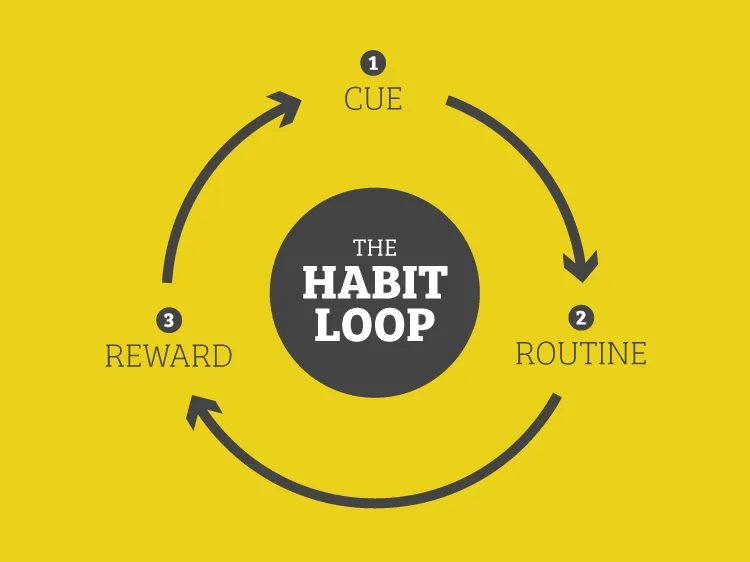
(Source)
In our context, the cue is the referral link, the routine is the process of sending referrals, while reward is the service credit or freebie that brands offer to the referrer. Now, as per Charles’ habit loop theory, the higher the reward, the greater the urge to complete the routine.
That means, brands could just double up their rewards to increase conversions. Sound simple, right? Unfortunately, that’s not how it works.
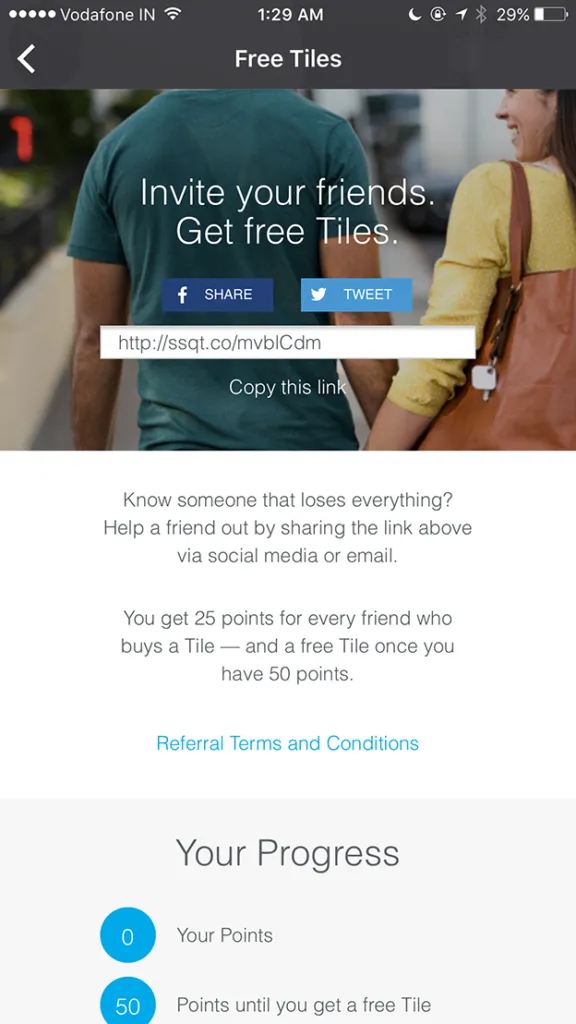
Consider this– Tile currently offers 25 points for every friend who successfully buys a tile, and a free Tile, once you have 50 points. Imagine if the reward was doubled, would the conversions increase?
Well, to answer that question, let’s first understand the implications this decision would have on users:
- Unfairness: Referral links would sound outright selfish and unfair to new users, since the referrer gets a free tile, while the referred user has to pay for it.
- Wrong Motivation: It would degrade the quality of referrals, since users feel motivated by the reward and not the actual experience.
- Social Stigma: Some users might not feel comfortable sharing referral links, as the reward system makes them look “selfish”
- Unit Economics: Brand would fail to keep up with the inequitable referral scheme, where there’s an inherent risk of CAC exceeding LTV.
Doesn’t look good, right?
So, even though the high reward scheme model complies to the habit loop, it is not a great way to improve conversions. Why, you ask?
That’s because… the habit loop is motivated by the desire to attain a pleasurable outcome, while the referral loop is driven by conviction and the desire to share an experience.
The difference is very subtle.
If a reward is huge, an individual might convince themselves that their intentions were motivated by the reward, not by the product experience, but if you offer a minimum reward, users would own their actions and stick to their convictions.
For instance, if Tile offered a free tile for every referral, it’s easy for an user to say that he referred the app, because he wanted a free tile. In other words, he could discredit his choice easily.
However, by deliberately reducing the reward and making it a little difficult to achieve, the system makes every referrer own their decision. Also, it balances the unit economics by making the cumulative LTV (3 product purchases) > overall CAC (1 FREE product).
That’s tip #5 for brands– create an equitable reward structure, such that cumulative (LTV – CAC) > ( total referral bonus).
For example, on two successful referrals by one user, Tile offers one tile to the referrer. Considering the LTV of every user as 1 tile, here’s what they would get:
LTV(1 + 1 + 1) – CAC (0 + 0.5 + 0.5) > 1 (Referral bonus) ⇒ 2 > 1, which means Tile has an equitable reward structure.
Apart from unit economics, you also need to consider whether you should be offering dual-sided rewards (Uber) or single-sided rewards (Tile)? Generally, dual-sided rewards have a higher conversion rate, since there’s enough motivation on both sides.
Lastly, this goes without saying, but it’s important to always provide service credits or free products in the reward scheme. Don’t offer rewards in any other form, as it impacts the effectiveness of the referral marketing strategy.
So, if I had to sum it up, unit economics, motivation and scalability — these are the three factors that you need to consider while deciding your referral reward structure.
Make them ‘Earn’ it.
“It’s the things you fight for and struggle with before earning that have the greatest worth.” – Sarah Dessen
As per classical economics, the actual value of an item is a measure that’s related to the cost it takes to produce it and sell it for profit, while the perceived value is what the customer believes the product is worth.
Generally, when the actual value of an item is less than its perceived value, it becomes easier to sell. On the contrary, when the actual value becomes greater than the perceived value, the product becomes difficult to sell.
In our case, we’re offering free service credits, which means we are decreasing its perceived value by increasing the overall supply.
In order to bring increase the perceived value again, we need to restore the balance by:
- Regulating supply: We need to ensure that service credits are distributed in an equitable way through proper backend verification.
- Creating demand: We need to encourage users to spend service credits on the platform.
That might sound too complicated, but it really isn’t.
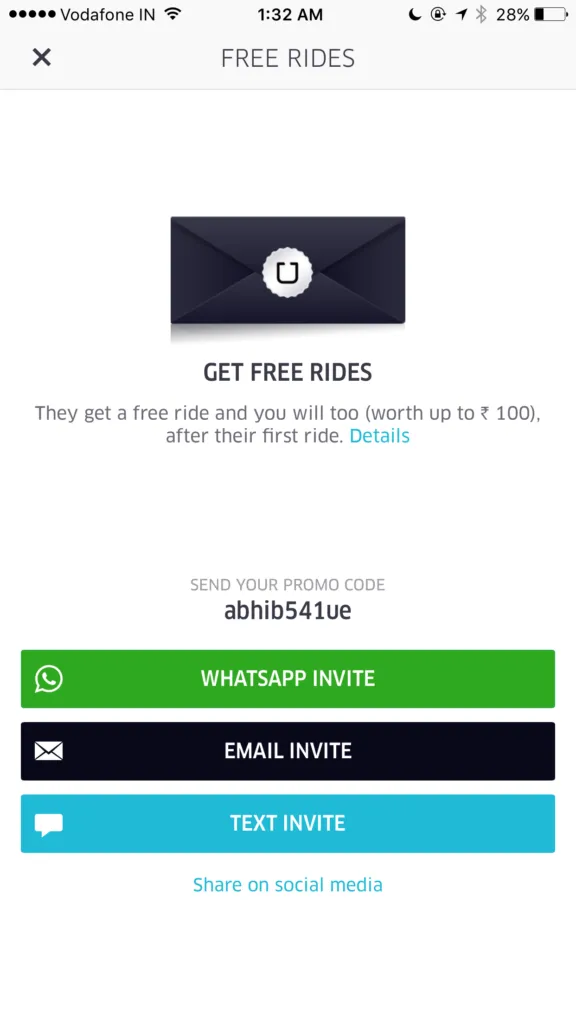
For instance, look how Uber cleverly maintains the balance by offering a FREE ride only after the referred user completes the ride.
Now by doing so, Uber…
- ensures that the referred user is a valid user and creates demand for the service by making him ride.
- regulates the credit supply by releasing referral credits only when the referred user successfully completes a ride and not when the referred user onboards the service.
Just by putting one simple pre-condition, Uber regulates both the supply and demand.
If you look at it from a psychological perspective, Uber increases the perceived value of its referral credits by making users work hard for it. If the service credits were passed on easily, there’s a risk that people might stop seeing the true worth of the service. But since referral credits are strongly regulated, they start appearing more rewarding to the users, as they feel they have earned the credits, and not merely received it for free.
That’s referral marketing tip #6 for brands– make your rewards valuable.
Create a Referral Tracking Dashboard
“Of all the sins, vanity is my favorite.”- Al Pacino
The key aspect of building a sustainable referral marketing campaign is gathering the trust of your users. And like every relationship, trust levels increase with better level of transparency and clarity.
Referral statistics are a great way of building trust with your advocates, as they provide clear, transparent and accurate insights to the user about their brand advocacy. Instead of second-guessing whether their friends signed up with their referral link, it allows users to track the signups and view their earned credits instantly from the referral dashboard.
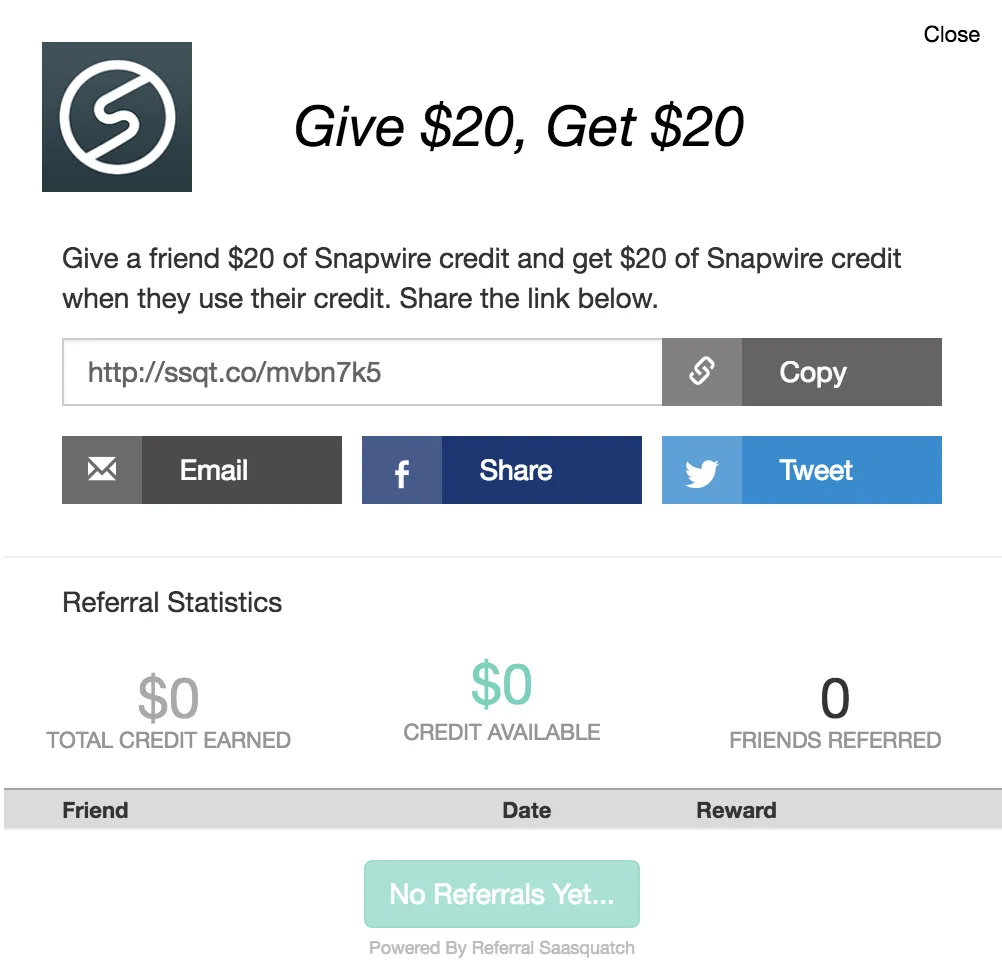
For instance, look how Snapwire gives a quick overview of all the user’s referral statistics. It shows the friends that you referred (number of users who used your referral code while signing up), total credits earned (cumulative credits earned through referral program), and credits available (amount that can be encashed, right now).
By showcasing crisp, aggregated and at-a-glance information to the user, Snapwire builds trust and confidence. As users keep referring, they’re able to constantly track their progress in the dashboard, and see if their friends are actually signing up and using the service.
Besides building trust, referral dashboards also offer a great bragging point, since it allows users to share their referral success instantly with their friends or family. For eg. “Look how much Uber cash I have?” or “Look how much I earned on Snapwire through referrals?”
Aligned with the social proof theory, that motivates other users to signup and become advocates. When users compliment referrers with “Wow. That’s amazing” or ask them questions like “how did you do it?”, the referrers feel special. They feel like they’re being rewarded for their actions. This sweet combination of instant gratification and social validation amplifies their desire to repeat the behavior and keep referring.
That’s referral marketing tip #7 for brands– Rewards tempt referrers, but numbers keep them.
Refine Your Strategy with Analytics.
“If you can’t measure it, you can’t improve it.” – Peter Drucker
Once you’ve created your referral marketing strategy, the next step it to use data to back up your idea or approach with behavioral data and usage patterns. That’s because the strategy that you formulated on the whiteboard might not work out as you had planned. Unintentionally, you might have left a few loose ends, which could hamper the influx of referrals and reduce conversions.
However, if you use data to analyze each and every step of your referral flow, you’ll be able to optimize data flows and fix underlying bottlenecks.
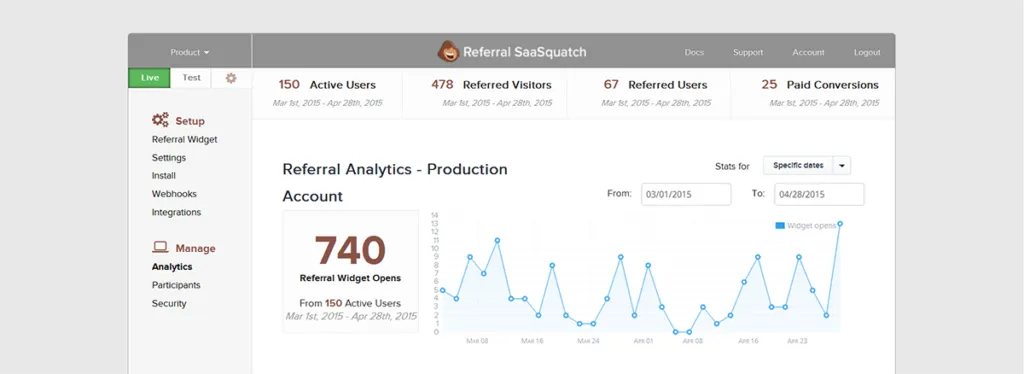
For instance, from the above Referral SaaSquatch dashboard, we can make out the number of active users on the app, the total number of referred visitors, actual referred users, widget opens and paid conversions.
If you look at the number of active users (150) and referred visitors (478), it shows that an average active user makes 3.2 referrals. We can also take a look at the actual number of referred users (67) vs referral visitors (478), that shows that 14% of them successfully sign up for a trial.
With this insight the company can feed that into their optimization campaigns by personalizing the onboarding experience, changing the invite text or testing the reward structure.
Since there’s no clear way to know which strategy is effective, we need to perform A/B testing. We need to tweak the CTA, referral message, visual design, reward structure, and test every possible alteration to see which one delivers the best outcome.
A/B Testing has been used by brands for years to increase profits, while maximizing engagement. For instance, EA managed to sell 1.1 million copies of its popular video game– SimCity 5 just by optimizing its promotional offer.
When performing A/B testing, a dedicated referral software really comes in handy, since it’s focused on optimizing referrals and showing numbers that matter.
Analytics gives you the ability to slice and dice the data to find emerging patterns, validate your hypothesis and learn from past mistakes. If I had to put it simply, analytics is the north star of your referral marketing strategy. It shows you the right path, whenever you feel lost, and keeps you focused on what’s important.
That’s referral marketing tip #8 for brands– use referral analytics to improve your program.